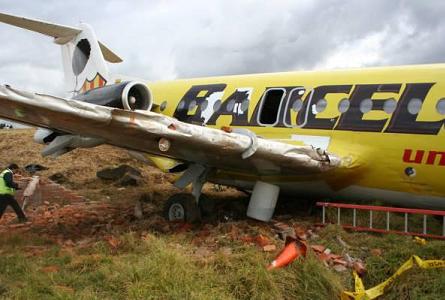Investigators in Ecuador believe a Fokker F28 crew was ill-prepared to abort take-off after a fire alert, and that the delay led the jet to overrun at Quito last year.
The inquiry found that the aircraft, operated by Icaro on a domestic flight to Coca, was attempting to depart from runway 35, which was wet, during a light tailwind.
About 35s after the twin-jet started its take-off run an audio alarm sounded, indicating a fire in the cargo hold.
But the crew hesitated in their response, initially opting to continue the take-off before deciding to abort - a delay of around 12s.
The aircraft had already reached 127kt, just shy of the V1 decision speed, and had also used up 86m of runway in the early stage of departure by rolling slowly before full thrust was applied.
By the time the pilots chose to reject the take-off the F28 had used up over 2,500m of the 3,120m runway. The delayed abort decision - combined with the tailwind and rain, and the jet's proximity to V1 - meant that the aircraft was unable to stop within the remaining length.
It careered into the instrument landing system, 167m off the runway end, and destroyed it before coming to a halt.
 |
|---|
© Ecuador DGAC |
Ecuador's civil aviation directorate states that the crew had not conducted a thorough briefing before take-off and was "not psychologically prepared for emergencies", resulting in "indecision" following the fire alarm.
The captain had 109hr on type, from 9,292hr in total, while the co-pilot had 3,889hr with 380hr on type.
The inquiry recommends strengthening crew resource management and heightening pilots' awareness of the risks of aborting take-off close to V1.
Although the jet was badly damaged in the overrun, on 22 September 2008, all 66 occupants survived. Analysis of the wreckage found no evidence of any fire in the cargo bay.
Source: Air Transport Intelligence news























